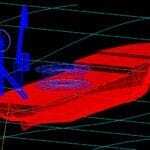Drag Anchor Design & Analysis
STA has specialized in the analysis and design of many anchors of many different types. These include:
- Conventional Drag Embedment Anchors, including HHC
- Deep-Diving Drag Embedment Anchors, also called VLAs
- Driven and Suction-Embedded Plate Anchors, including SEPLAs
- Driven, Bored and Suction Embedded Pile Anchors
- Propellant Embedded Plate Anchors
- Torpedo (Dropped) Embedded Anchors
- Gravity (Deadweight) Anchors
Drag Anchor Selection
In many projects where conventional drag anchors are used, the selection of the most suitable anchor is simple. The maximum load that the anchor is required to hold is determined from a dynamic mooring analysis. After applying a safety factor, an anchor is selected that can supply the required load in the seabed soil at the mooring location. Drag anchors are sold by their design type and weight. However, different anchor designs have different holding capacities for any given weight.
STA provided clients with a simple anchor selection app, STA ANQUICK, which is illustrated below. The available data for the selection of an appropriate anchor is more detailed than most engineers realize.

The above figure shows a possible range of more than 20 proprietary anchor designs that satisfy the simple requirement to hold a design load of 80 kips (36 MT) with a Safety Factor of 1.5. There are two sets of results, one for the case of a soft clay, or mud, seabed, and the other for the case of a sand, or stiff clay, seabed. Note the very large range of anchor weights require to resist the design load. They vary from 3.1 kips for the most efficient anchor types, to 56 kips for the least efficient. Clicking on the button Go to Specific Anchor Sheet on the left, takes the user to a sheet where more design data for a specific anchor type, in a soft clay, or mud, seabed is entered.
Detailed Results for a Soft Clay, or Mud, Seabed

In the example above, a Danforth anchor, which is in Group Type 5 for mud, has been entered. The required weight for this type of anchor, 12.9 kips, taken from the 1st sheet is also entered. Now a table of design data is shown for typical API RP2SK intact, and damaged safety factors is shown, with alternative numbers for quasi-static and dynamic mooring analyses. Additional safety factors are shown for temporary conditions, again for quasi static and dynamic mooring analyses.
Detailed Results for a Sand, or Stiff Clay, Seabed

The same Danforth type anchor is in Group Type 7 for the sand seabed. It needs to weigh just 9.4 kips, from the table on the 1st sheet. Similar API RP2SK safety factors are shown for a quasi-static and for a dynamic mooring analysis.
Graphical Results from STA ANQUICK



The first two charts above show the design point for the selected anchors for the case of mud or the case of a sandy seabed. The performance of other anchor designs is easy to compare. The third graph shows the ultimate and proof load requirements from the original input data, for any anchor type in a sand, or stiff clay, seabed.
Anchor Drag Distance Required to Reach Proof Load

Specific Anchor Design Detailed Result Sheet

Example Project Anchor Costs, 2017
On a 2017 Port Security Barrier Project in Canada, a total of 24 drag embedment anchors were required. They all had different maximum dynamic design loads. They were grouped into 9 load ranges, varying from 13 kips to 80 kips (5.9 MT to 36.3 MT, or metric tons). STA provided cost guidance to the client for procuring the anchors, both new and used, based on $/lb of anchor weight for each anchor type. The full cost estimate table is shown below.

The cost data was provided by Anchor Marine, Houston. Not all anchors could be found in the optimum size, so substitutes were made. However, clearly the least expensive solution would have been to procure all used anchors from the types in the upper rows. Anchor types in the last two rows are HHP anchors, which commanded higher cost/lb and were not readily available.
More Detailed Anchor Analysis, STA ANCHOR
STA ANCHOR is a program for predicting the performance of drag embedment anchor systems in sea bed soils. Version 3.01 is for cohesive soils only. The anchor system is defined as the anchor and the attached mooring line (wire or chain) which is buried with the anchor up to the level of the sea bed. The program predicts the anchor system performance in terms of applied mooring load, anchor burial depth, buried mooring line geometry, and many other parameters.
There are four sets of information the user must input: anchor data, line data, soil data, and control parameters. Numerous macro buttons are available to help the user input information and to run the program. An Ultimate Load Sheet, a Proof Load Sheet, and a Comparison Sheet are provided, enabling the user to produce a comprehensive report on the anchor system behavior.
The Version 1.0 program was partially developed during a Joint Industry-funded Project organized by Omega Marine International, where 2-ton and 7-ton drag anchors were tested in the Gulf of Mexico in the summer of 1990. Results from these tests were used to calibrate STA ANCHOR Version 1.0. The Version 3.0 program was partially developed during another Joint Industry-funded Project. However, most of the development effort has been funded internally by STA. The program was substantially modified from the earlier version in order to be able to include vertically loaded anchors (VLAs) in an analysis. Version 3.0 of the program deals with cohesive soils and silts, which have strength properties which can be characterized by an undrained shear strength depth profile.

View the User Manual for STA ANCHOR.
The forces acting on the fluke and shank of an anchor as it embeds are calculated in finite steps by STA ANCHOR. An equilibrium depth is reached where downward forces from the anchor are balanced by upward forces from the chain or wire dragging the anchor.




STA ANCHOR is an advanced analysis developed by STA and written primarily by Bil Stewart. The interested reader is referred to the User Manual for full documentation. STA ANCHOR is used by STA and other owners to evaluate new anchor designs in simple soils and existing designs in complex layered soils. STA ANCHOR is also used to calculate the reduced, but still quite acceptable, holding capacities of drag anchors as the mooring line force at the seabed has an uplift angle.
STA ANCHOR includes the program STA CHAIN, which runs as an iterative subroutine in STA ANCHOR as eqilibrium is sought at each finite displacement step.


